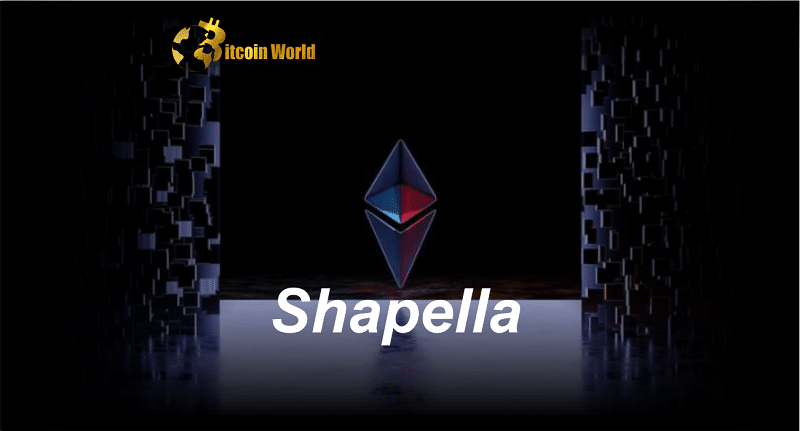The wait is finally over! After months of anticipation, the Ethereum network has successfully implemented the Shapella hard fork on its mainnet. This pivotal upgrade marks a significant milestone in Ethereum’s evolution, officially enabling validators to withdraw their staked Ether (ETH) from the Beacon Chain. Let’s dive into what this means for the Ethereum ecosystem and what we’ve seen in the immediate aftermath of this highly anticipated event.
Shapella is Here: Validators Can Now Access Staked ETH
At precisely 10:27 p.m. UTC on April 12th, at epoch 194,048, the Shapella upgrade went live, ushering in a new era for Ethereum’s proof-of-stake (PoS) consensus mechanism. For those unfamiliar, the Beacon Chain has been the engine powering Ethereum’s PoS since The Merge in September 2022. However, until Shapella, the ETH staked on the Beacon Chain by validators remained locked. This upgrade changes everything, giving validators the long-awaited ability to access their staked assets and accumulated rewards.
In the first hour alone, data from the Ethereum block explorer beaconchai.in reveals a flurry of activity. A total of 12,859 ETH was unlocked through 4,333 withdrawal transactions. This initial surge demonstrates the pent-up demand and eagerness of validators to manage their staked ETH. Currently, around 44% of the active validator pool – that’s 248,043 out of 559,549 validators – are eligible to initiate either partial or full withdrawals.
What Kind of Withdrawals Are We Seeing?
Early data suggests that validators are primarily withdrawing their staking rewards. The majority of withdrawals observed in the initial hours ranged between 2.8 and 3.2 ETH. This size aligns with the typical reward accumulation for validators, indicating that many are opting to claim their earnings. Interestingly, data from Rated Network Explorer shows that only 3,996 validators had queued for complete exits just before Shapella went live. This suggests a cautious approach from validators, with many initially focusing on reward withdrawals rather than full exits.
| Metric | Value |
| Total ETH Withdrawn | 12,859 ETH |
| Number of Withdrawals | 4,333 |
| Withdrawal Size Range | 2.8 – 3.2 ETH (Majority) |
Who Holds the Most Withdrawable ETH?
Blockchain analytics firm Nansen provides intriguing insights into the distribution of withdrawable Ether. According to their data, crypto exchange Huobi holds a significant 30% of the total withdrawable ETH, followed by the decentralized autonomous organization PieDAO at 17.7%. Furthermore, Nansen reports that 284,622 ETH is currently queued for full withdrawal from 7,948 validators. These figures highlight the concentration of staked ETH within certain entities and the potential for larger withdrawals in the coming period.
Market Impact: Did the Price of ETH React?
Despite predictions of potential market volatility, the price of Ether has remained relatively stable in the initial hours following the Shapella hard fork. Trading around $1,920, the price movement has been minimal. This aligns with earlier analysis from blockchain intelligence company Glassnode, who anticipated a muted immediate price reaction in their April 11th report.
The Ethereum Foundation itself acknowledges the potential for a substantial release of ETH back into the market. They estimate that 18.1 million ETH, currently valued at over $34.8 billion, is staked on the Beacon Chain and potentially withdrawable. However, it’s crucial to understand that mechanisms are in place to prevent a sudden flood of ETH hitting exchanges.
Glassnode’s analysis projected that less than 1% of the total staked ETH would likely be released in the first week. The 12,859 ETH unlocked in the first hour represents a mere 0.07% of the total Ether staked on the Beacon Chain, reinforcing the expectation of a gradual and controlled withdrawal process.
Shapella: A Step Closer to Ethereum’s Vision
The technical mechanism enabling these withdrawals is Ethereum Improvement Proposal EIP-4895. This proposal facilitates the transfer of staked Ether from the Beacon Chain to the Ethereum Virtual Machine (EVM), the execution layer of Ethereum. In essence, Shapella completes the transition to a fully functional proof-of-stake Ethereum by bridging the Beacon Chain and the EVM for ETH withdrawals.
Considered the most significant upgrade since The Merge, Shapella is more than just about unlocking staked ETH. It represents a crucial step forward in realizing Ethereum’s long-term vision of a scalable, secure, and sustainable blockchain. By enabling withdrawals, Ethereum solidifies the economic incentives for validators to participate in network security, further strengthening its PoS consensus.
Looking Ahead: What’s Next After Shapella?
With Shapella successfully implemented, Ethereum continues to evolve. Here are some key takeaways and what to watch for:
- Gradual Withdrawals: Expect ETH withdrawals to occur gradually over time, preventing market shocks. The initial data supports this, with validators seemingly prioritizing reward withdrawals.
- Validator Dynamics: Shapella might influence validator behavior. Some validators might choose to withdraw rewards regularly, while others might adjust their staking strategies. We could see shifts in staking concentration over time.
- Ecosystem Growth: The ability to withdraw staked ETH reduces risk for validators and could attract more participants to staking, further decentralizing and securing the network.
- Focus on Future Upgrades: The Ethereum development community is already looking ahead to future upgrades aimed at improving scalability, efficiency, and user experience. Shapella is a foundational step paving the way for these advancements.
In Conclusion: A New Chapter for Ethereum
The Shapella hard fork is a resounding success for the Ethereum network. It delivers on a long-standing promise to validators, unlocks billions of dollars in staked ETH, and solidifies Ethereum’s position as a leading proof-of-stake blockchain. While the immediate market impact has been muted, the long-term implications for validator participation, network security, and the overall health of the Ethereum ecosystem are profoundly positive. Shapella marks not just the end of a chapter, but the exciting beginning of a new one for Ethereum.
Disclaimer: The information provided is not trading advice, Bitcoinworld.co.in holds no liability for any investments made based on the information provided on this page. We strongly recommend independent research and/or consultation with a qualified professional before making any investment decisions.


